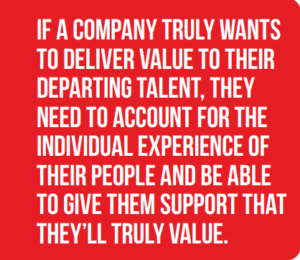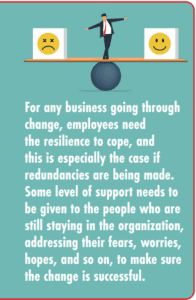Supporting employees on their way out can be a challenge, but these approaches will make a difference for all in the long run.
By Simon Kent
Exiting staff is never an easy part of HR management. While the reasons for parting company with staff can be diverse, those reasons generally begin in other parts of the organisation—decisions about efficiency, company direction, geographical considerations, and so on. But ultimately, it will come down to HR to determine the how and sometimes the who of a redundancy programme.
“One of HR’s main functions is to maintain a positive relationship with departing employees,” says Sophie Bryan, founder of workplace culture consultants Ordinarily Different, “and one of the ways they can do this is by supporting them in finding new opportunities.
This includes providing positive references and networking opportunities for future employment. HR can also facilitate connections in the industry or share information about job fairs and networking events, introducing new pathways where one can find employment.”
Bryan also suggests that while employees may have gained skills during their employment, redundancy can be an opportunity to identify areas for improvement and even offer training initiatives to enhance future employability.
However, delivering this kind of support may not be so straightforward. If a company truly wants to provide value to their departing talent, they need to account for the individual experience of their people and their needs. Offering a one-size-fits-all set of options, or even giving access to options without any direction as to what individuals should do next, can be counterproductive. Employees may feel they’re just having resources thrown at them by way of compensation.
“A good outplacement service is versatile enough to deal with different individuals’ needs, offers a blended approach, including personal support from a career coach and access to useful career learning resources, as well as business intelligence and job market information,” says Corinne Mills, managing director of U.K. career coaching and outplacement company Personal Career Management.
Simon Lyle, managing director U.K. of outplacement and career coaching services business Randstad RiseSmart, agrees there are a wide range of factors at play when an individual needs to leave an organisation.
His suggestion is to channel resources through a coach, an independent professional who can offer expert guidance for those about to transition.
“Professional, personalised career transition coaching means you can provide tailored support that meets the individual where they are at. For some that may be spending a lot of time in the discovery phase and working through their strategy. Others may want to test their thoughts on developed ideas and then get quickly into executing their plan. Then it’s about having access to job opportunities that are curated to the specific needs of the individual,” he says, “and that saves people time in terms of accessing routes to market.”
A career transition coach starts with a blank sheet of paper and helps the individual address the necessary elements for making their next successful move. “The role of the coach is key,” says Lyle. “The coach is the enabler, the person who can bring the right resources together to deliver a positive experience for the transitioning employee, whatever their circumstances. For example, when a coach knows someone has an interview coming up, the coach can direct them to relevant resources, help them practice answering questions, or facilitate research on the potential employer. The coach ensures the right support is there at the right time and reflects the type of support each individual needs during their job search, which is very important.”
Interestingly, Lyle also emphasises the importance of deploying an effective redeployment strategy within an organisation. There can sometimes be the situation where employees are being asked to leave in one part of the business while another department is looking for
talent. “When you’re looking at a downsizing you really want to think of this holistically,” says Lyle. “Providing a professional redeployment programme, with provision of professional career coaching might mean individuals consider roles they wouldn’t have otherwise thought and then get the support they need to maximise their chances of how to approach those internal roles, so they may not need to leave and even have to access outplacement.”
Delivering an outplacement service from an external source rather than from HR itself will mean the function has more time to concentrate on other aspects of the employment change. If this is part of a wider restructuring, for example, an external outplacement service enables HR to concentrate on other aspects of the restructuring that will bring success.
While the leaver support is crucial, HR should also consider the perception and feelings of the people who will remain in the organisation. For any business going through change, employees need the resilience to cope, and this is especially the case if redundancies are being made. Some level of support needs to be given to the people who are still staying in the organization, addressing their fears, worries, hopes, and so on, to make sure the change is successful.
Both Lyle and Mills highlight the importance of providing outplacement support in the context of maintaining or building employer brand. Insensitive downsizing—the sacking of people by text message/email/group Zoom call and so on—will not put the organisation in a good their work to others and protect the reputation of the business. Sensitively off-boarding employees reduces people’s anger, lessens conflict, and helps create a more positive alumni of ex-employees who you may even want to re-hire in the future.”
Ultimately the resources provided to and treatment of employees up to their final day in employment all contribute to that persons’ overall experience of the business. As Lyle notes, in the age of Glassdoor and other social media, ensuring the entire employee experience is a positive one is important. “Outplacement isn’t just a financially savvy move. It’s a moral imperative that boosts morale and loyalty with remaining employees by showing we care for every employee’s journey, beyond our doors. From an overall employee experience, you need to consider the first day they work for you up until the first day they do something else,” he says. “The experience people have over that time shows how the company values their employees. Maintaining a strong employer brand means the business is better placed when its time to hire again. This can mean more people applying or even recommended to you, lower costs of hiring, and more offers accepted.”
When handled correctly, off-boarding employees does not need to be disruptive to the business and may even be another opportunity to demonstrate how much the company cares.
















